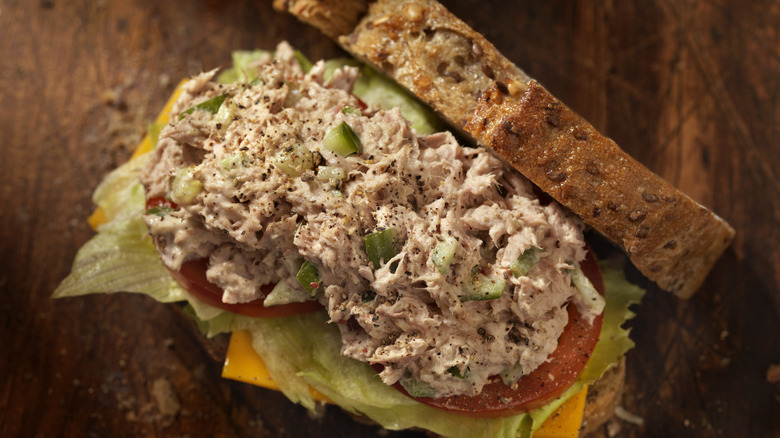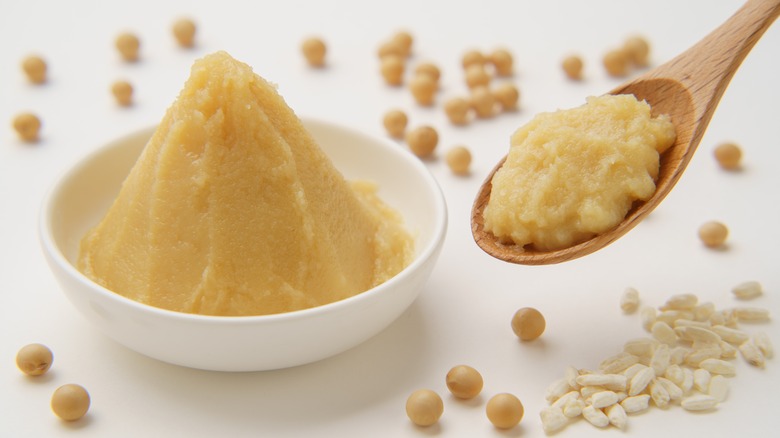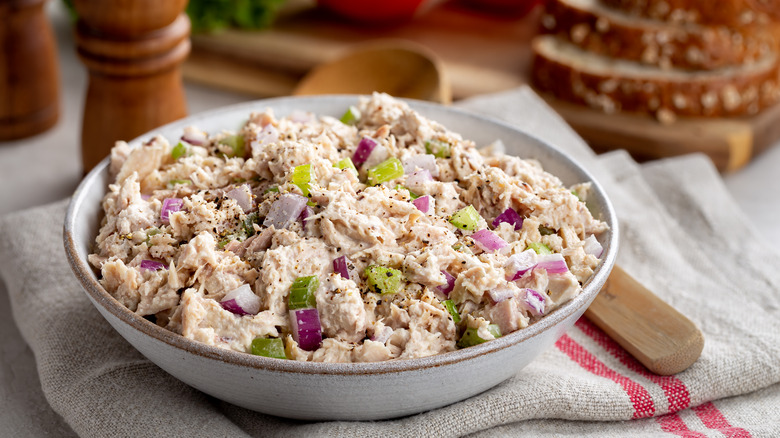Swap The Salt In Your Tuna Salad For The Ultimate Umami Upgrade
Tuna salad is just one of those foods. The creamy, tangy, protein-packed salad is a lunch staple. Usually consisting of a can of tuna combined with mayonnaise, salt, pepper, and other fillings such as onion or celery, the dish is as basic as it is delicious. But sometimes the classic mayo-based salad can feel a bit too basic. However, there is no need to put that can of tuna back in the pantry. Instead, try giving your tuna salad a scoop of deliciousness by adding in miso to your recipe.
The fermented soybean paste can give your salad a good dose of umami, and makes an interesting replacement for salt in the dish. Miso is a key ingredient in Japanese cuisine, and offers a complex, warm taste that rounds out the flavors of many dishes from soup to chocolate chip cookies. Miso can do the same for your tuna salad sandwich as well. The umami elements of miso add a savory depth to tuna salad that salt simply can't. There is also a sweetness to miso (especially white miso) that is both unexpected and tasty. Trust on this one, once you make your tuna salad with miso, the salad will taste incomplete without it.
A scoop of miso makes all the difference
Only 1 tablespoon of miso is needed for this trick, as miso is a concentrated ingredient. You will also want to be mindful about which miso you use, as different miso varieties have varying levels of saltiness and concentration of flavor. For this recipe, white miso, also known as shiro miso, works best. Shiro miso is made of fermented soybeans, barley, and rice. It has a toasty and umami flavor, but it also has a lightly sweet taste that makes it a great ingredient to mix into the tangy tuna salad.
In addition to its wonderful taste, miso also has another key benefit: probiotics. Due to its fermented nature, miso is rich in probiotics, which can help to improve gut health and digestion. Miso is really pulling double duty in the lunchbox classic. These days, you can find miso in most big box grocery stores, as well as Asian supermarkets, which are also more likely to carry a wide variety, each with a different flavor profile. And while white miso might be the most versatile, there is a whole world of miso to explore.
Building on that miso scoop
Now, a scoop of miso does wonders for improving a typical batch of tuna salad. But what if the addition of miso was just a jumping off point to build the ultimate umami salad? Building off of the toasty taste of miso, adding ingredients such as sesame seeds (bonus points if you toast them) is a great way to complement the warmth of your miso. Sesame seeds also bring in a good bit of crunch to your salad that might otherwise be missing.
Furikake also makes for a great tuna salad mix-in. The seasoning mix typically consists of dried seaweed flakes, sesame seeds, red pepper flakes, and other flavorings that come together to make a totally unique flavor. Furikake matches the flavor of miso well and brings in a brininess (thanks to the seaweed) that is both unexpected and perfectly fitting for the seafood salad. This, along with classic additions such as freshly chopped green onions and celery can really round out the dish's flavor profile.
You can also switch up the base of your salad by using Kewpie mayo rather than a typical American mayonnaise. Kewpie mayonnaise differs from typical mayo in that it contains only egg yolks rather than whole eggs, which gives it a richer texture and flavor that will bring your salad to a whole new level of tastiness. Pair with seaweed paper or Japanese milk bread to really make this dish pop.


